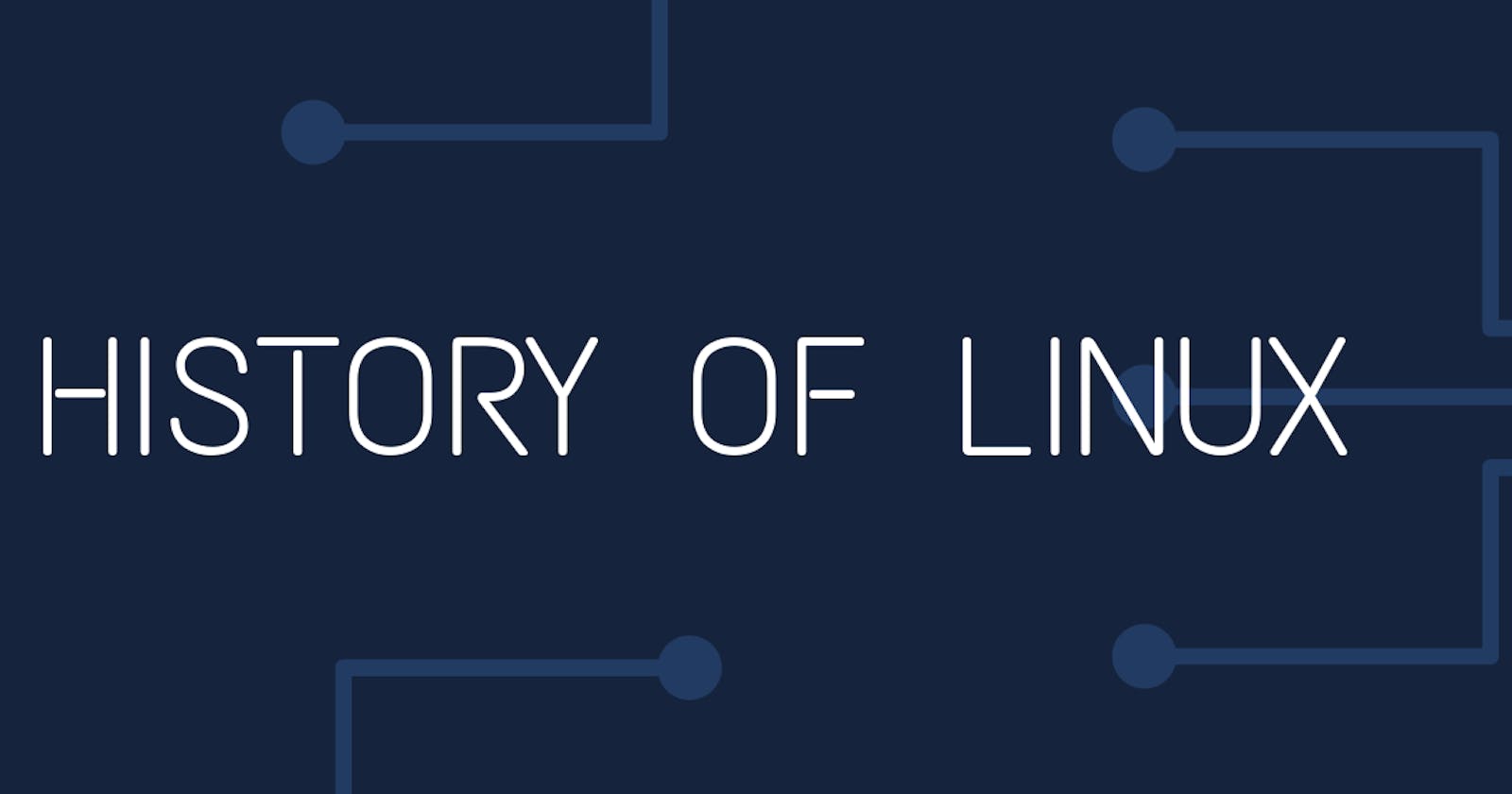The history of Linux

About
Linux turned 30 in 2021. The first Linux kernel was made public on September 17, 1991. So what exactly is Linux? Linux is a community of open-source operating systems that are developed on top of the Linux kernel. Linux comes packaged within Linux distributions.
What about Linux distributions?
Linux distributions, or fondly called distro, are nothing but software collections based on the Linux kernel and a package management system. Users get to use Linux generally by downloading and installing a distro into their machines. We’ll have a more detailed discussion about Linux distributions in the later part of this write-up.
Linux was written by Finnish-American Software Engineer Linus Benedict Torvalds. Are you interested to know the history of Linux? How was it created? What’s the story behind the development and naming? How did Linux come under the GNU GPL license? What’s Linux mascot? What are the latest developments? What’s there between Microsoft and Linux?… Then this article is just for you. Let’s start!
What Inspired Creating Linux ??
AT&T was dropped from Multics. This led to the invention and implementation of the Unix OS in 1969. Unix was created by American Computer Science legends Kenneth Lane Thompson and Dennis MacAlistair Ritchie of AT&T Bell Labs. And the first version was released in 1970.
2 years later they created C out of UNIX. And there comes the future base of many programming languages! C added portability and availability to UNIX and thus it became increasingly popular, widely adopted, modified, and copied by businesses and academic institutions across the globe. AT&T was the sole owner of the UNIX copyrights.
American Programmer Richard Matthew Stallman began the GNU project to create a free UNIX-like operating system in 1983. He wrote GPL (GNU General Public License) as a part of his project. By the 1990s, there was enough software to build a complete operating system. However, Hurd, the GNU kernel couldn’t pull enough development work leaving GNU incomplete.
In 1987, American-Dutch Professor Andrew S. Tanenbaum wrote UNIX-like system MINIX for academic use. The source code of MINIX was made available for everyone, however, MINIX couldn’t be either modified or redistributed. MINIX’s 16-bit architecture wasn’t well adapted to Intel’s increasingly popular 386 design for PCs. It became highly expensive for private users to use UNIX for Intel 386 personal computers.
And this led to Linus Torvalds’ beginning of a new project. Later Linus Torvalds stated that if either 386BSD or GNU Hurd was available during his time, he wouldn’t be interested in writing his project.
Torvalds’ Linux Development
On August 25, 1991, Linus Torvalds began his project while studying at the University of Helsinki. This very project turned out to be the Linux kernel. It was based on MINIX. Also, GNU C Compiler was used in the development. Torvalds’ new program was for the hardware used by him and independent of any OS. Linus aimed to use the functions of his PC having an 80386 microprocessor. Years later in 2001, Torvalds penned down his autobiography Just for Fun: The Story of an Accidental Revolutionary. In the book, he mentioned he started his project as
“just a hobby” and ended up with an OS kernel. Then he was only 21 and announced the new project via a Usenet Newsgroup comp.os.minix.
So, what’s a Usenet Newsgroup? A Usenet Newsgroup is nothing but a Usenet repository used for updates posted by its users. They are basically discussion groups. and not particularly used for publishing news. Newsgroups are not technically but functionally the same as discussion forums. Newsreader clients are used for reading newsgroup content.
As per Linus Torvalds, Linux started gaining importance after porting X Window System to Linux created by Orest Zborowski. If you want to learn more about Orest Zborowski this interview might interest you. X Window System or X11 is common on UNIX-based operating systems. It’s windowing for bitmap displays.
The Story Behind the Name Linux
Linus Torvalds had Freax in mind as the name of Linux. Torvalds created Freax as an amalgamation of three words – Free, Freak, and X from UNIX. For about half a year, Linus Torvalds used Freax as his file storage. Initially, Linux was considered but dismissed as it might sound “egotistical”.
In September 1991, FUNET’s FTP server was used to upload files for the purpose of development. However, Ari Lemmke at HUT (Helsinki University of Technology), one of the FTP’s volunteer administrators, wasn’t quite fond of the name Freax. So, he altered the name as Linux on the FTP server. Later Torvalds consented to the same.
Torvalds added an audio guide to the Linux kernel source code to correctly pronounce the word Linux. Although the kernel was often used with other software of the GNU Project, the designation “Linux” was primarily used only for the kernel. It’s in fact, kernel very quickly became GNU software’s most popular adoption.
In June 1994, Linux was called a “free UNIX clone” in GNU’s bulletin. Also, the Debian Project named its product Debian GNU/Linux. In May 1996, Stallman published Emacs 19.31 editor. In the same, Linux became Lignux combining GNU and Linux. But soon GNU/Linux was favored over Lignux.
The name GNU/Linux garnered mixed reactions from the Linux community and users. Debian and the GNU projects preferred to use this name. But people generally liked to use Linux.
Role of GNU GPL in Linux
The first Linux kernel was published under its very own license. This had some restrictions on commercial activities. However, the first Linux kernel 0.01 was released with a GNU Bash shell’s binary. The software included was developed under the GNU GPL or GNU General Public License. It was a part of the infamous GNU project. Linus Torvalds wrote the “Notes for linux release 0.01”. In this note, he mentioned the GNU software required to run Linux. Also, he revealed that most of the tools come under the GNU copyleft. Now, what’s copyleft? Copyleft is the practice where you are authorized to modify and freely distribute intellectual property. And you’ll be required to preserve the rights in derivatives created out of that same property. Copyleft licenses are able to maintain copyright conditions of documents, computer software, art, etc. The information required for Copyleft is generally in source code file formats.
Torvalds wanted to release the Linux kernel under the GNU GPL License in 1992. And he made this announcement in the release notes version 0.12. In mid-December of the same year, Torvalds published version 0.99 with the GNU GPL license. Linux and GNU developers’ joint efforts integrated Linux with GNU components to create a fully functional free OS. Linus once made a statement by saying –
“making Linux GPLed was definitely the best thing I ever did.” Around 2000, Linus Torvalds announced Linux kernel comes under the GPLv2 license. After years of drafts and discussions, in 2007, Torvalds released GPLv3. But the majority of Linux developers including Torvalds wasn’t ready to adopt the new license.
Linux Mascot
In 1996, Linus Torvalds made the announcement of a Linux Mascot. When the Linux team was into the mascot selection, Torvalds mentioned a personal story. It was about a little penguin that had bitten him when he visited the National Zoo & Aquarium of Canberra, Australia. Then the team considered a penguin to be the official Linux mascot.
American Programmer Larry Ewing presented the draft of today’s Linux mascot based on Linus’ experience with the little penguin. James Hughes suggested Tux as the name of the mascot. Tux came from Torvalds’ UNIX, along with being the contraction of the Tuxedo having a similar color to that of the penguin.
Linux Distributions
While talking about Linux, Linux distributions can no way be skipped, because Linux distributions complete Linux as an operating system and a community altogether.
In 1991, after developing the kernel, Linus Torvalds distributed the first version, 0.01 as only a source code. Later a downloadable floppy disk image pair was also distributed. This pair contained one bootable disk image including the Linux kernel and another disk image having a set of GNU utilities, tools to set up a file system.
However, the installation procedure wasn’t that easy. Linux distributions worked like wonders to ease up installations, and especially in the face of increasing software availabilities. H. J. Lu’s “Boot-root”, a downloadable disk image pair including Linux kernel and the minimal tools, can be called the first Linux distribution available released in 1991. Other early distros include MCC Interim Linux, Softlanding Linux System or SLS, and Yggdrasil Linux/GNU/X, all in 1992.
SLS wasn’t maintained well. So, a new distribution, Slackware based on SLS, was released in July 1993. Patrick Volkerding is the developer and maintainer of the same. Also, Ian Murdock created Debian as a free Linux distribution and released it in December 1993. So, Slackware and Debian are the two oldest and still running Linux distributions.
Linux distributions garnered positive responses from the users as the DOS and Windows alternatives in IBM PC compatible machines, Mac OS in the Apple Macintosh, and UNIX’s proprietary versions. People used to use UNIX in their schools and/or workplaces. Linux distributions were appreciated for being low-cost or completely free, and for providing source code.

